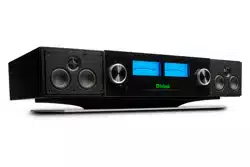Loading ...
Loading ...
Loading ...

7
AUX
The AUX input accepts a 3.5mm stereo
male connector for analog signals. This
is also known as an 1/8 inch stereo
mini plug, and is the typical end used
to connect headphones to phones or
similar devices. This input can be
used to provide a wired connection to
various music sources.
This input can be chosen by turning the Left Knob to
the AUX position. (Figure 8 on page 8.)
HDMI ARC (Connecng your TV)
The RS200 can receive audio via an HDMI cable from
ARC enabled televisions. Audio Return Channel (ARC)
can provide two way communication between units
allowing for volume control and lip-syncing functions
to ensure audio and video are perfectly matched.
This allows for more intelligent operation between
components as well as less cable clutter. Make sure
this feature is enabled in your TV’s setup menu.
The Lip Sync function is automatic with an ARC CEC
connection. Lip Sync can be controlled with the RS200
remote control and will enable adjustments of audio to
sync with accompanying video when CEC is defeated
or with optical or USB input.
The HDMI ARC input is designed to be used exclusively
with ARC compliant televisions. If the source is not
ARC compliant, use the optical connection for digital
sources.
USB
The RS200 can be connected to a computer using a
USB connection. Connect the computer using a USB
cable Type A to Type B cable.
For Apple MacIntosh computers running OSX version
10.6.4 and above, connect using the above cable. USB
Audio Class 2.0 is natively supported in these OSX
versions so the RS200 is now connected.
For Windows 7, 8, 8.1, 10 (32 & 64 bit), a driver is
needed. Download the driver from mcintoshlabs.com.
The Driver will be found in the Products section of
the website under the RS200. Download the McIntosh
USB driver for the RS200.
• Go to the directory of the downloaded le.
• Right click on the le.
• Extract the les.
• Click on the XMOS USB le to run it.
• Install the driver by agreeing. Click “yes”, “next,”
or “Install” to all questions. In other words, agree
to all its terms.
• When asked to reconnect the Device, plug in the
USB cable that is connected to the RS200.
• Finish the install.
When complete, the RS200 will be a speaker option.
To select, go to “Devices” or “Devices and Printers”
depending on the version of Windows. Right click on
the RS200 Icon.
Choose “Sound Settings.”
Right click on the XMOS speaker option and choose
“Set as Default.”
If you choose USB with the left knob (or push INPUT
on the remote until USB is chosen), sound from the
computer should be heard.
Data Output
The Data Output uses a 3.5mm stereo male-to-
male cable to send control signals
to connected McIntosh source
components. For instance, a PLAY
command to a CD player can be sent
using a single remote control.
Trig Out (Power Control)
Trig Out uses a 3.5mm stereo male
to male cable to send on/off signals to other connected
McIntosh components using a 12-
volt trigger signal. This allows
other components to automatically
power on and off when the RS200
does the same.
Service
This blocked USB port is only for service by qualied
persons, and is not intended for USB device support or
playback.
Subwoofer Output
An external subwoofer can be connected using an RCA
jack. The subwoofer will receive a line level mono
signal. RS200 lters will automatically be optimized
for integration with an external Subwoofer when
connected and volume will track accordingly. Use the
Subwoofer’s sensitivity adjustment to set the initial
level. A crossover setting of 100Hz is suggested.
Figure 4– 3.5mm
Plug for AUX Input
Left
Ground
Right
Figure 5– USB Type B Connector
Power
Control
Ground
N/C
Data
Signal
N/C
Data
Ground
Figure 6– 3.5mm
Plug for Data Output
Figure 7– 3.5mm Plug
for Power Control
Loading ...
Loading ...
Loading ...
